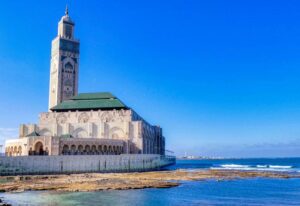Day 1 : Casablanca Med V airport – Transfer to (Hotel)

Upon arrival in Casablanca, the biggest city in the country; you will be met and transferred to your hotel. (It depends on your arrival time.
Day 2: Casablanca – Rabat – Fes
Leaving Casablanca the economic capital of Morocco, we then travel to Rabat, where we will see the Oudaya Kasbah and its beautiful gardens, This Kasbah of Oudaya is located at Abou Regreg river. It was built during the reign of the Almohad dynasty in 1150 AD. The Mausoleum of Mohamed V and Hassan II, and Hassan Tower which is the minaret of an incomplete mosque in Rabat was constructed in 1195 AD. The tower was intended to be the largest minaret in the world with the mosque. After we finish our sightseeing tour in Rabat,. we head to Fez on the express road. On the road you will be fascinated by thousands of olive trees and farmlands on the two side of the road . On arrival to Fes, we check into the hotel for the night.
Day 3 : Fes (Sightseeing Tour with your tour guide, Fes Medina)
Explore Fes, the intellectual capital known as the Mecca of the West and Athena of Africa. With a population of around 1 million, Fes is Morocco’s second-largest city. Divided into three parts, Fes El Bali, the oldest surrounded by walls with over 9000 narrow streets; Fes-Jadid or the new Fes, home to the Mellah (Jewish quarter); and Ville Nouvelle, created during French occupation. Fes El Bali is a UNESCO World Heritage Site with the world’s largest medina. Visit the University of Al-Karaouine, the oldest university founded in AD 859.
Day 4: Fes – Moulay Driss- Volubilis – Meknes
Travel back to the 3rd century by visiting Volubilis, the most important archaeological site in Morocco with well-preserved Roman ruins, a UNESCO World Heritage site. Continue to Meknes, named after the Berber tribe Miknasa. Explore the granaries built by Moulay Ismail, the capital during his reign (1672-1727). Stop at the impressive Bab Al Mansour gate, built in the 11th century.
Day 5: Meknes – Midelt – Ziz valley – Erfoud – Merzouga
Embark on a long driving day, passing through Ifrane, nicknamed “Little Switzerland” for its greenery and ski resort. Lunch in the Berber village of Midelt, on the foothills of the High Atlas Mountains. Cross the mountains, witness palm tree oases, and reach the pre-Saharan zone via Errachidia and Erfoud. Explore Erfoud’s pottery and fossils quarries. Head to Merzouga, with its red-colored sand dunes of Erg Chebbi. Dinner and night in a hotel.
Day 6: Merzouga – Erg Chebbi (Desert Exploration – Camel Trekking for sunset)
Drive through the sand dunes on the edge of Erg Chebbi, encountering nomadic black tents. Visit a nomadic family for tea and experience Touareg village life in Khamlia. After a short break, embark on a camel ride to witness a stunning sunset in the high sand dunes of Merzouga. Stay in a Berber tented desert camp for a night under the stars.
Day 7: Merzouga – Rissani – Todra gorges
Visit Rissani, exploring the Mausoleum of the founder of the Alaouite Dynasty. Rissani, once a major caravan center, remains a commercial hub. Proceed to Todra Gorges, impressive canyons in the High Atlas Mountains. Enjoy a hike in the canyons. Dinner and night in a hotel in the area.
Day 8 : Todra Gorges – Dades Valley – Ouarzazate
Travel the Road of 1000 Kasbahs, passing enormous kasbahs on both sides. Visit Amarhidil Kasbah and pass through Boumalne, situated on the edge of Dades Valley. Explore the Valley of Roses, known for its cosmetic products. Reach Ouarzazate, the Hollywood of Africa, with notable kasbahs like Taourirt. Ouarzazate is a renowned film-making location. Dinner and night in a hotel.
Day 9: Ouarzazate – Ait Benahddou – Taroudant
35 km from Ouarzazate there is the fortified Kasbah of Ait Benhaddou, which was built in the 11th century. Once up on a time this Kasbah was the former caravan route between the Sahara and Marrakesh. It is situated on a hill along the Ounila River and has some beautiful examples of kasbahs, which unfortunately sustain damage during each rainstorm and windstorm. Most of the town’s inhabitants now live in a more modern village at the other side of the river; however, around five families are still living within this Kasbah.. After Ait Benhaddou Kasbah’s visit , we will drive via Taroudant city for the accommodation in a hotel.
Day 10: Taroudant – Agadir – Essaouira
About 70 kms from Taroudant, is the city of Agadir . The capital of Berbers since it is the biggest Berber city of the kingdom. Agadir is also a very modern city that is located on the shore of the Atlantic Ocean, near the foot of the Atlas Mountains. It has the most important fishing and commercial port of Morocco, it is the first sardine port in the world, (exporting cobalt, manganese, zinc and citrus). It is also a seaside resort with long sandy beaches.
Because of its large buildings, wide roads, modern hotels, and European-style cafes, Agadir is not a typical city of traditional Morocco, but it is a modern, busy and dynamic town and very famous for its sea food. Along the ocean we drive for almost 200 kms towards Essaouira. On the Atlantic ocean this town has white painted houses with blue windows and doors, a well-designed picture. Since the 16th century, Essaouira has also been known by its Portuguese name of Mogador. The Berber name means the wall, a reference to the fortress walls that originally enclosed the city. Dinner and night in a hotel in Essaouira.
Day 11: Essaouira (Explore Essaouira at your own pace)
A day of your own leisure . You can explore and enjoy Essaouira is it is well renowned for its kite surfing and windsurfing, with the powerful trade wind. Horse riding, camel riding along the beach, quad biking are activities that you can enjoy while staying in Essaouira. It is known by the delicious seafood too. In Essaouira, several small art galleries are found all over the town. Since 1998 Essaouira is getting known by its Gnaoua Festival of World Music, normally it is scheduled in the last week of June. It brings artists from all over the world. Although focused on Gnaoua music, it includes rock, jazz and reggae. In early 1952 the film director and actor Orson Welles made his movie Othello. Now there is a square named Orson Welles. Or you could just spend the rest of the day relaxing in your hotel.
Day 12: Essaouira – Marrakech
About half way between Essaouira and Marrakesh you will see enormous Argan trees on both sides of the road. These Argan trees are frequently climbed by goats. Argan oil is produced by several women’s cooperatives and it is used to prepare couscous, salads, and is traditionally used as a treatment for skin diseases before being founded as good enough for cosmetics by European manufacturers. A stop at one of these cooperatives is worthy to see how Berber women squeezed the Argan fruits between hands to extract this precious oil. We arrive to our hotel in Marrakesh and if time permits we will go out for a walk.
Day 13: Marrakesh
In the morning a full guided tour will be scheduled to discover Marrakesh which is known as the “Red City”. Marrakesh is the most important former imperial city in Morocco’s history. It is situated near the foothills of the snow-capped Atlas Mountain. Like all the old cities, Marrakech comprises both an old fortified city, The Medina, and a very modern city called Gueliz, built during the French occupation. Marrakesh has the largest traditional market (souk) in Morocco and also has one of the busiest squares in Africa and the world, Jamaa el Fna. The square is full of story-tellers, water sellers, dancers, snakes charmers and musicians. During the night the square turns into a huge open-air restaurant.
During our visit we will see The Koutoubia Mosque, built in the 12th century in the reign of Almoravid Dynasty. We will go through narrow streets and allies in the ancient city. We will pass by “seven saints” which during the reign of Moulay Ismail, the festival of the seven saints was founded by the request of the Sultan. The tombs of several renowned figures were moved to Marrakesh to attract pilgrims. Walk back to the hotel for dinner and night.
Day 14: Marrakesh (Explore Marrakesh Markets at your own pace)
After the full guided tour, you will be able to discover more of this Red City of Marrakesh on your own and become familiarized with the alleyways of the medina. You may go on a shopping tour on your own in a local market and the scattered shops by the Square or spend your last night enjoying the traditional moroccan facilities of your hotel.
Day 15: Marrakesh – Casablanca Med V Airport
A private transfer from Marrakesh to Casablanca Med V airport according to your flight details will be aranged.
what’s inclusions
what’s excluded


